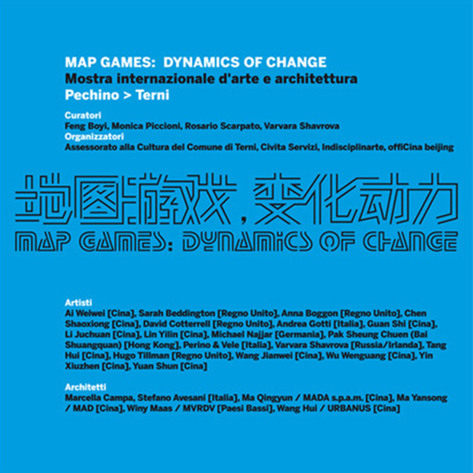MapGames: Dynamics of Change (Terni)
Venue: Centro Arti Opificio Siri (CAOS) and Palazzo Primavera in Terni, ItalyCurators: Feng Boyi, Monica Piccioni (offiCina beijing), Rosario Scarpato (offiCina beijing), Varvara Sharova.
Date: 1st March 2009
Participating Artists
Ai Weiwei, Bai Shuangquan-tozer pak [hk], Sarah Beddington [uk], Anna Boggon [uk], Chen Shaoxiong, David Cotterrell [uk], Andrea Gotti [italy], Guan Shi, Li Juchuan, Lin Yilin, Michael Najjar [germany], Perino & Vele [italy], Varvara Shavrova [russia/ireland], Tang Hui, Hugo Tillman [uk], Wang Jianwei, Wu Wenguang/Wen Hui, Yin Xiuzhen, Yuan Shun, Zhan Wang.
Participating Architects
Marcella Campa + Duliao Studio [Li Wenjun, Stefano Avesani, italy], Ma Qingyun [Mada Spam], Ma Yansong [Mad], Winy Maas [Mvrdv, Netherlands], Wang Hui [Urbanus]
On March 28, 2009 Italian art and culture scene welcomed a new exhibition space, CAOS “Centro per le Arti Opificio Siri” in Terni, a city in central Italy that is experiencing an important process of urban development focused on culture and innovation.
CAOS, converted from the old chemistry factory ex siri and covering an area of 6000 sqm will be a place unique in its kind in Italy hosting national and international exhibitions, creative laboratories, the new contemporary section of O.Metelli picture gallery, the city archaeological museum, a 300-seat theatre and the modern coffee-bookshop. As anticipated by its name CAOS, a merry, experimental and innovative atmosphere will distinguish the new art centre.
On the occasion of the opening of CAOS, Terni was the second European city and the third one in the world, after Birmingham (UK) and Beijing (China) to host the contemporary art and architecture exhibition ‘Map Games: Dynamics of Change’. Starting from a reflection on the dynamics of changes of urban China, the exhibition investigates the theme of contemporary in art and architecture.
The city symbol of Map Games is Beijing. Since winning the bid for hosting the 29th Olympic games, it has been the focus of continuous international attention. The face of the city has been changing dramatically. Consequently Beijing, the city of the 3rd millennium, has become an elusive entity, both exciting and exhausting.
Twenty four Chinese and international artists and architects explore the dynamics of these changes, and in their multi-layered interpretations of the city, map out Beijing’s past, present and future.
The show is one of the few in Italy to combine works by both Chinese and international artists and architects. Many of them have been specially commissioned for the exhibition, which explores the role of the Map within the rapidly expanding and changing metropolis.
For the Map Games exhibition, Ai Weiwei - the artistic consultant for the design of the Birds Nest Olympic Stadium - has contributed a video called Beijing: The Second Ring which documents the two opposite views of traffic flow on 33 bridges along Beijing’s Second Ring.
An interesting aspect is the observation of the city space when it stages itself as a theatrical setting and reveals the surreal aspects of existence. This often happens in non-places such as a highway (the photographic work They… by well-known conceptual artist Wang Jianwei), a money-cashier machine (Sarah Beddington) or through a role-playing that brings again to the attention the question of true and false, artificial and real (Lin Yilin).
A deserted space with a floor covered with concrete powder defines Yin Xiuzhen’s Map. This map made of void and cement conveys a universal feeling of desolation associated not only with Beijing but also with all other urban wastelands on the Planet.
The environmental question is an important thematic focus also for other participants in Map Games. Founder of MAD Architects, Ma Yansong advocates “green thinking” and proposes the installation of a green arterial line in the middle of Beijing city, thus virtually freeing urban dwellers from pollution and providing an escape from the city’s alienating daily life.
Other architects such as Marcella Campa and Stefano Avesani rethink the identity of the city recomposing the segments of a complex reality in transformation with a multiform, open project that explores the spatial and social aspects of the traditional hutong districts in Beijing. Their research is planned and structured as a multi-step experience, being enriched each time with new reflections, materials and installations (www.instanthutong.com).
The social issue is also central in the thought-provoking piece of Hong Kong-based Pak Sheung Chuen (Tozer Pak) entitled ‘A Present to Central Government’ as well as in the ‘Chinese Villager Documentary / Photo Project’ by documentary and video director Wu Wenguang.
From installation and sculpture to video, photography, painting and drawing, participating artists and architects have investigated the theme of Map Games using different media and materials. Some paintings put in relation architectural icons and the self: that of the artist’s personal imagination (Tang Hui) or that of the global web community (Chen Shaoxiong).
In the exhibiting space, all fragments of the vast metropolis that have emerged out of the minds of all the map games players will come together into one dynamic whole. Here we will not only see continuity and interruption, reflections on culture, history and present life experience, but also get a glimpse of an imaginable future.

